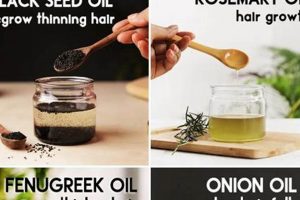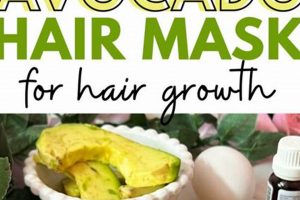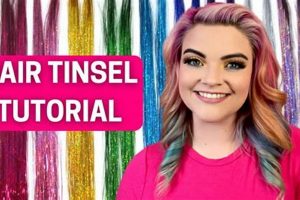The creation of a homemade texturizing spray, often utilizing salt as a primary ingredient, offers a method for achieving beach-like waves and enhanced volume in hair. This involves combining ingredients such as salt, water, and optionally, moisturizing agents and essential oils, to formulate a solution that mimics the effects of saltwater on hair strands. The resulting mixture is typically applied to damp hair and allowed to air dry or can be styled with heat for varied textural effects.
This approach to hair styling provides several advantages, including cost-effectiveness and control over ingredient composition, allowing individuals to avoid potentially harmful chemicals found in commercially produced products. Historically, the effect of saltwater on hair has been recognized for its ability to add texture and body. The reproduction of this effect at home offers a convenient alternative to natural exposure, particularly for those without regular access to coastal environments. The practice aligns with the growing consumer interest in natural and customizable beauty solutions.
The subsequent sections will delve into specific recipes, ingredient considerations, and application techniques involved in the process of formulating such texturizing sprays at home. The goal is to equip the reader with the knowledge necessary to create a product tailored to their specific hair type and desired styling outcome.
Tips for Optimizing Homemade Texturizing Sprays
Achieving optimal results when crafting a texturizing spray requires attention to detail in both formulation and application. The following guidelines provide insights for enhancing the efficacy and longevity of the homemade product.
Tip 1: Salt Selection. The type of salt used significantly impacts the outcome. Sea salt is generally preferred for its mineral content, but Epsom salt can provide additional volume and hold. Table salt, due to its refined nature and potential additives, should be avoided.
Tip 2: Hydration Balance. Salt can be drying to the hair. Incorporating moisturizing agents like aloe vera juice, argan oil, or a lightweight conditioner is crucial for maintaining hair health and preventing excessive dryness. Adjust the quantity based on individual hair porosity.
Tip 3: Essential Oil Integration. Essential oils not only contribute fragrance but can also provide beneficial properties. Lavender or rosemary oil can promote scalp health, while citrus oils can add shine. Ensure the chosen oil is compatible with hair and skin, and use it sparingly to avoid irritation.
Tip 4: Formulation Consistency. Thoroughly dissolve the salt in warm water before adding other ingredients. This ensures even distribution and prevents gritty residue. Use a spray bottle with a fine mist nozzle for consistent application.
Tip 5: Application Technique. Apply the spray to damp, not soaking wet, hair. Scrunch the hair while spraying to encourage wave formation. Avoid over-application, which can lead to stiffness. Start with a light mist and add more as needed.
Tip 6: Heat Styling Considerations. If using heat styling tools after application, use a heat protectant spray to minimize damage. The salt in the texturizing spray can increase sensitivity to heat. Lower heat settings are recommended.
Tip 7: Storage Practices. Store the homemade spray in a cool, dark place to preserve the integrity of the ingredients. A tinted glass bottle can further protect the mixture from light degradation. Discard any unused portion after a month to ensure freshness and prevent bacterial growth.
Implementing these tips allows for the creation of a personalized texturizing spray that effectively enhances hair texture while mitigating potential drawbacks. Individual experimentation is encouraged to refine the formula to specific needs.
The subsequent section will address potential issues and troubleshooting techniques associated with using homemade texturizing sprays.
1. Salt Type
The selection of salt constitutes a foundational decision in the creation of a do-it-yourself sea salt hair spray. The specific type of salt employed directly influences the final product’s texture, hold, and potential impact on hair health. For instance, sea salt, harvested from evaporated seawater, retains a diverse array of minerals such as magnesium, potassium, and calcium. These minerals are hypothesized to contribute to hair strength and scalp health. However, sea salt’s varying particle size can also impact the evenness of the spray and the degree of texture it imparts.
Conversely, Epsom salt (magnesium sulfate), while technically a salt, offers different characteristics. Its primary effect is to add volume and body to the hair, potentially creating a more dramatic, albeit potentially drier, result compared to sea salt. Table salt, due to its processing and additives like iodine, is generally discouraged. The iodine can react negatively with some hair types, leading to discoloration or dryness. The finer grain of table salt may also result in a less textured and more uniform coating on the hair.
Therefore, careful consideration of salt type is paramount. The choice dictates not only the aesthetic outcome, in terms of wave definition and volume, but also the overall health and manageability of the hair. Experimentation with different salt types and concentrations allows for customized formulations that align with specific hair types and desired effects. The informed selection of salt type represents a critical step towards achieving the intended benefits of a homemade texturizing spray while mitigating potential adverse outcomes.
2. Water Ratio
Water constitutes the base solvent for the salt in any texturizing spray formulation, and its ratio to other ingredients fundamentally dictates the spray’s efficacy. An insufficient water quantity leads to oversaturation of salt, resulting in a spray that is excessively drying and potentially leaves a gritty residue on hair. This oversaturation can also cause stiffness and difficulty in styling. Conversely, an excessive water ratio dilutes the salt concentration, diminishing the texturizing effect and rendering the spray ineffective. The water ratio influences not only the immediate texture but also the long-term health of the hair. A balanced ratio is thus crucial for achieving the desired beachy waves without compromising hair integrity.
Practical application requires careful measurement and titration. A common starting point is a 1:8 salt-to-water ratio (e.g., one tablespoon of sea salt to eight tablespoons of water). This ratio should then be adjusted based on hair type and desired level of texture. Individuals with fine or dry hair may require a higher water ratio to prevent excessive drying, while those with thick or oily hair may benefit from a slightly lower water ratio to enhance the texturizing effect. The temperature of the water also plays a role; warm water facilitates salt dissolution, ensuring a more consistent product. Post-application observation of hair texture and moisture levels allows for iterative refinement of the water ratio.
Optimizing the water ratio presents a critical aspect of formulating a suitable spray. The correct balance allows for texturizing effects while minimizing adverse impact on hair health. Experimentation and adaptation based on individual hair characteristics enables users to achieve desired styling outcomes, underscoring the fundamental role of water ratio within texturizing spray formulation.
3. Moisturizing Agent
The inclusion of a moisturizing agent in homemade sea salt hair spray is not merely an optional addition but a necessary component for maintaining hair health and achieving desirable styling outcomes. The primary function of salt, regardless of type, is to draw moisture from the hair shaft, creating the textured, beachy effect. This process, however, can lead to excessive dryness, brittleness, and damage if not counteracted. The moisturizing agent serves as a buffer, replenishing lost moisture and providing lubrication to prevent these adverse effects. For instance, without a suitable moisturizer, frequent use of the spray may result in split ends, breakage, and a generally unhealthy appearance, negating the intended aesthetic benefit.
Various substances can serve as effective moisturizing agents within this context. Lightweight oils, such as argan or coconut oil, are commonly used for their ability to penetrate the hair shaft and provide lasting hydration. Aloe vera gel or juice offers a water-based alternative, delivering moisture without adding excessive weight. Humectants like vegetable glycerin or honey attract moisture from the air, helping to maintain hydration levels within the hair. The choice of moisturizing agent depends on individual hair type and desired styling outcome. Fine hair may benefit from lighter options like aloe vera juice, while thicker or drier hair may require the intensive hydration provided by oils. The concentration of the moisturizing agent must also be carefully considered; an excessive amount can weigh down the hair and diminish the texturizing effect, while an insufficient quantity fails to adequately mitigate the drying effects of the salt.
In summary, the strategic incorporation of a moisturizing agent is essential for balancing the drying effects of salt and safeguarding hair health. Its function extends beyond mere hydration, playing a pivotal role in preserving hair elasticity, preventing damage, and enhancing overall styling results. The informed selection and application of moisturizing components are thus indispensable for successful and sustainable utilization of homemade sea salt hair sprays.
4. Optional Additives
The incorporation of optional additives in homemade texturizing sprays represents a refinement of the basic formula, allowing for customization based on individual preferences and hair needs. While the core components of salt, water, and a moisturizing agent provide the foundational texturizing and hydrating effects, optional additives can enhance the product’s fragrance, conditioning properties, and overall performance.
- Essential Oils for Scent and Scalp Health
Essential oils, such as lavender, rosemary, or tea tree oil, are often added for their aromatic qualities. However, certain essential oils also possess properties that can benefit scalp health. For example, rosemary oil is believed to stimulate hair growth, while tea tree oil possesses antimicrobial properties that may alleviate scalp conditions like dandruff. The concentration of essential oils should be carefully controlled, typically limited to a few drops per batch, to avoid irritation or allergic reactions. The selection of oils should align with individual sensitivities and desired therapeutic benefits.
- Hair Conditioners for Enhanced Softness
A small amount of leave-in hair conditioner can be integrated to further enhance the moisturizing effect and improve hair manageability. The conditioner coats the hair shaft, reducing friction and preventing tangling. Lightweight, water-based conditioners are preferable to avoid weighing down the hair. The specific type of conditioner should be chosen based on hair type and porosity. For example, protein-rich conditioners may benefit damaged or chemically treated hair, while humectant-based conditioners are suitable for dry, porous hair.
- Natural Extracts for Added Benefits
Plant-derived extracts, such as green tea extract or chamomile extract, can contribute antioxidant and soothing properties. Green tea extract contains polyphenols that may protect hair from environmental damage, while chamomile extract offers anti-inflammatory benefits that can calm irritated scalps. The inclusion of these extracts provides an additional layer of protection and care, complementing the texturizing effects of the spray.
- Glycerin for Enhanced Moisturization
Glycerin is a humectant, drawing moisture from the air into the hair shaft. Adding a small amount of glycerin to a homemade texturizing spray can enhance its moisturizing capabilities, particularly in humid environments. However, overuse of glycerin can lead to product buildup and a sticky feeling, especially in dry climates where there is little ambient moisture to draw upon. Therefore, it’s crucial to use glycerin sparingly and adjust the amount based on the climate and individual hair needs.
The judicious use of optional additives allows for a personalized texturizing spray that caters to specific hair concerns and preferences. By carefully selecting and incorporating these ingredients, individuals can create a product that not only enhances hair texture but also promotes overall hair health. The decision to include these additives should be based on a thorough understanding of their properties and potential effects, ensuring a balanced and effective formulation.
5. Application Method
The manner in which a homemade texturizing spray is applied directly influences the final styling outcome and the overall health of the hair. Proper application techniques are crucial for maximizing the spray’s texturizing effects while minimizing potential drawbacks such as dryness or product buildup. Therefore, understanding and implementing appropriate application methods are integral to the successful utilization of the texturizing spray.
- Hair Dampness Level
The level of dampness in the hair at the time of application significantly affects the spray’s distribution and efficacy. Applying the spray to completely dry hair often results in uneven distribution and stiffness. Conversely, applying it to soaking wet hair dilutes the spray, diminishing its texturizing capabilities. Ideally, hair should be damp, allowing the spray to adhere evenly and penetrate the hair shaft without being overly diluted. Post-shower towel-drying, or misting dry hair until damp, is recommended.
- Spray Distribution Technique
The method of distributing the spray across the hair ensures uniform coverage and prevents concentrated product buildup in specific areas. A consistent misting action, holding the spray bottle approximately six to eight inches away from the hair, promotes even distribution. Sectioning the hair and applying the spray in layers can further enhance coverage, particularly for individuals with thick hair. Avoid directing the spray at a single point for an extended duration, as this can lead to localized stiffness and residue.
- Scrunching and Manipulation
Scrunching the hair while or immediately after applying the spray encourages wave formation and enhances texture. This involves gently squeezing sections of hair from the ends upwards towards the roots. Varying the intensity and direction of the scrunching motion creates a more natural and less uniform wave pattern. For individuals seeking greater definition, twisting small sections of hair before scrunching can amplify the wave effect. The goal is to manipulate the hair to encourage the desired texture as the spray dries.
- Air Drying vs. Heat Styling
The choice between air drying and heat styling after application affects the final texture and the potential for hair damage. Air drying preserves the natural texture encouraged by the spray, resulting in a softer, more relaxed wave. Heat styling, such as using a diffuser or curling iron, amplifies the texture and provides greater definition and hold. However, heat styling also increases the risk of dryness and damage, particularly when used in conjunction with salt-based products. If heat styling is desired, it is advisable to use a heat protectant spray prior to application and to utilize low heat settings.
The application method is an indispensable factor in determining the effectiveness and safety of homemade texturizing spray. By carefully considering the hair’s dampness level, spray distribution technique, scrunching and manipulation methods, and the choice between air drying and heat styling, individuals can optimize the spray’s texturizing benefits while minimizing potential damage. The successful application of texturizing spray necessitates a thoughtful and adaptable approach, tailoring the method to individual hair characteristics and desired styling outcomes.
6. Storage Conditions
The preservation of homemade texturizing spray integrity relies significantly on appropriate storage conditions. Improper storage can degrade the constituent ingredients, leading to reduced efficacy, altered consistency, and potential microbial contamination, thereby diminishing the spray’s intended benefits.
- Temperature Stability
Elevated temperatures accelerate the degradation of many organic compounds. Storing texturizing spray in a warm environment, such as a sunlit bathroom, can cause essential oils to lose their fragrance and moisturizing agents to break down, diminishing their intended effects. Conversely, extreme cold can cause water-based formulations to separate or freeze, altering the spray’s texture and application properties. Maintaining a stable, moderate temperature, ideally between 15C and 25C, is crucial for preserving the integrity of the mixture. Practical application necessitates avoiding direct sunlight and storing the spray in a cool, dark location, such as a cabinet or drawer.
- Light Exposure
Exposure to light, particularly ultraviolet (UV) radiation, can catalyze chemical reactions that degrade light-sensitive ingredients within the texturizing spray. Essential oils, natural extracts, and even some preservatives are susceptible to photodegradation, leading to diminished efficacy and potential changes in color or odor. Storing the spray in a clear container exacerbates this effect. Utilizing opaque or tinted glass bottles minimizes light exposure and protects the spray from UV-induced degradation. Transferring the spray to a dark-colored bottle or storing it within a closed cabinet represents practical methods for mitigating light-induced damage.
- Container Material
The material of the storage container can influence the stability of the texturizing spray. Certain plastics can leach chemicals into the mixture, potentially altering its composition and posing a risk to hair health. Glass bottles, particularly dark-colored glass, are generally preferred due to their inert nature and resistance to chemical interactions. Additionally, the container should be airtight to prevent evaporation of volatile components and minimize the risk of microbial contamination. Regularly inspecting the container for signs of degradation, such as cracks or discoloration, is essential for maintaining the spray’s quality.
- Microbial Control
Homemade texturizing sprays, lacking the robust preservative systems found in commercial products, are susceptible to microbial growth. Contamination can occur through the introduction of bacteria, fungi, or mold, leading to spoilage and potential skin irritation. Implementing sanitary practices during formulation, such as using sterilized equipment and distilled water, minimizes the risk of contamination. Regular inspection of the spray for changes in odor, color, or texture, which may indicate microbial growth, is crucial. While natural preservatives like grapefruit seed extract can be added, their efficacy is limited. Discarding the spray after a defined period, typically one to two months, is a prudent measure for ensuring product safety.
Effective maintenance of a homemade texturizing spray hinges on attentive storage practices. By mitigating temperature fluctuations, limiting light exposure, selecting appropriate container materials, and controlling microbial contamination, individuals can extend the shelf life and preserve the efficacy of their homemade creations. Implementing these storage protocols ensures consistent performance and minimizes the risk of adverse effects on hair health, thereby reinforcing the value of appropriate preservation techniques.
Frequently Asked Questions Regarding Homemade Texturizing Sprays
This section addresses common inquiries and clarifies potential uncertainties surrounding the formulation and use of texturizing sprays crafted at home. The information provided aims to enhance understanding and promote safe and effective practices.
Question 1: What is the typical shelf life of a homemade texturizing spray?
The absence of robust preservatives in homemade formulations necessitates a limited shelf life. Generally, a homemade spray should be discarded after one to two months, irrespective of apparent condition. Microbial contamination and ingredient degradation can occur without overt visual cues.
Question 2: Can table salt be substituted for sea salt?
While technically feasible, the use of table salt is discouraged. Table salt often contains additives, such as iodine, which can negatively impact hair health or cause discoloration. Sea salt, with its mineral content, is generally considered a superior alternative.
Question 3: How can excessive dryness resulting from the spray be mitigated?
Excessive dryness can be addressed by increasing the concentration of moisturizing agents, such as argan oil or aloe vera juice, in the formula. Additionally, reducing the frequency of spray application and utilizing a deep conditioning treatment on a regular basis can help to counteract the drying effects.
Question 4: Is it necessary to use distilled water when formulating the spray?
The use of distilled water is recommended but not mandatory. Distilled water minimizes the risk of introducing contaminants into the spray, thereby extending its shelf life. However, thoroughly boiled and cooled tap water may serve as an acceptable substitute.
Question 5: Can essential oils damage the hair or scalp?
Essential oils, while beneficial in certain contexts, possess the potential to cause irritation or allergic reactions, particularly when used in high concentrations or by individuals with sensitive skin. It is imperative to use essential oils sparingly and to conduct a patch test before widespread application.
Question 6: How does humidity affect the performance of the spray?
Humidity can significantly impact the performance of the spray. In humid environments, the spray may cause hair to become sticky or weighed down due to the humectant properties of ingredients like glycerin. Adjusting the formula to reduce the concentration of humectants may be necessary to optimize results in humid climates.
The presented information aims to provide clarity and guidance regarding the formulation and use of homemade texturizing sprays. Individual experimentation and adaptation are encouraged to refine the formula based on specific needs and conditions.
The subsequent section will explore advanced techniques for enhancing the performance and longevity of homemade texturizing sprays.
Conclusion
The comprehensive exploration of how to make diy sea salt hair spray has elucidated the multifaceted aspects of its formulation, application, and preservation. Key determinants of success encompass salt selection, water ratios, moisturizing agent integration, optional additive utilization, application methodologies, and storage environments. The interplay of these factors dictates both the aesthetic outcome and the sustained health of the hair.
The informed application of these principles empowers individuals to craft customized solutions tailored to their unique hair characteristics and styling aspirations. However, adherence to recommended guidelines and a commitment to ongoing observation are essential for maximizing benefits while mitigating potential adverse effects. The pursuit of optimal hair texture through homemade sprays demands a synthesis of knowledge, experimentation, and diligent practice.







